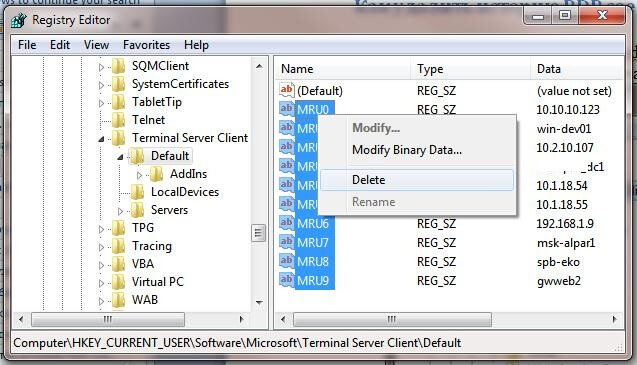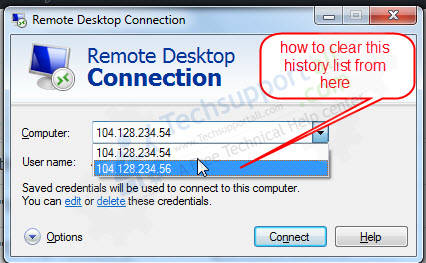How to Delete Remote Desktop Connection History?
Today we will discuss How to delete remote desktop connection history. After you utilize the Remote Desktop connection history tool to connect to a different pc, the name of the pc you connected to is added to the Remote computer change posture list box. This makes it straightforward for you to choose a similar pc at a later time quickly. People ask about RDP client while searching best desktop for college students. However, the Remote Desktop Connection computer tool doesn’t offer the simplest way to clear the computer list or remove one or additional entries from the pc box.
How to delete remote desktop connection history in Few Steps?
When you use a Remote Desktop connection, it forever saves the association data, including IP Address and User name, for you mechanically. For some purpose, it’s done to create things straightforward for you. The consecutive time you wish to attach, you don’t need to enter the knowledge once more and might connect with the pc. How long does it take to reset a pc windows 11 necessary to ask with RDP queries.
Strategies to Clear RDP Connection History

Clear RDP Cache from Registry
The Registry stores the knowledge regarding RDP connections. It’s impossible to remove a pc from the list of RDP connection history by Windows tools. Users should manually clear some registry keys to clear RDP connection history.
Step 1
Press WIN + R and then type “Regedit” to open the Registry Editor.
Step 2
Navigate here: HKEY_CURRENT_USER > Software > Microsoft > Terminal Server Client. Then you can see two registry keys: Default and Servers.
Step 3
First, expand the Default Key, which can contain the most recently used connections. Here you solely have one entry. Right-click it, so select Delete. If you have many entries, you’ll delete them one by one.
Step 4
Second, expand the Servers key. This contains the small print of all the RDP client connections that have ever been made of this machine. Select the user you wish to delete, then right-click UsernameHint to delete it.
Step 5
Finally, delete the Default.RDP file found in your home path. This is often a hidden file and not shown or deleted by Default. Open your electronic communication, so enter the subsequent delete command:
del/ah %homepath%\documents\default.RDP
Clear RDP Cache Using Command Lines
In the 1st technique, we’ve mentioned the way to clear RDP connection history manually. If you feel it’s too difficult and long, then you’ll find conjointly mechanically clear the RDP cache via CMD.
Step 1
Press WIN + R and then type in “cmd” to open the Command Prompt.
Step 2
Enter the subsequent commands and press enter one by one. Here we tend to take the primary command as an example. You should enter consecutive commands once the previous operation has been completed successfully.
- reg delete “HKEY_CURRENT_USER\Software\Microsoft\Terminal Server Client\Default”/VA /f
- reg delete “HKEY_CURRENT_USER\Software\Microsoft\Terminal Server Client\Servers”/f
- reg add “HKEY_CURRENT_USER\Software\Microsoft\Terminal Server Client\Servers”
- del /ah %homepath%\documents\default.rdp
How to Clear Saved RDP Credentials
Suppose the user selects the choice to Allow me to avoid wasting credentials before getting into the identification for a replacement RDP connection. In that case, the username and identification are remembered within the Windows Credential Manager. How to get rid of little green check marks on desktop icons also lead people toward RDP. The RDP consumer can use the antecedently remembered identification for authentication on the remote host consecutive times you connect with a similar pc. Therefore, follow the steps below if you need to delete the windows credential manager rather than the entire data.
Step 1
Press Win + S to open the Search box. Type in credential Manager, so it opens it.
Step 2
Switch to Windows Credentials. Realize the credential you wish to delete, so click take away.
How to Delete a History List in Remote Desktop

The Microsoft Remote Desktop connection tool permits users to access another computer remotely, provided it’s come upon properly for the Remote Desktop connection computer. The remote desktop disconnected because another connection was made a major issue nowadays. Whenever the Remote Desktop program is employed to attach to a different pc, Windows saves a listing of every connection within the History List. Clearing the History List significantly involves a little labor with the Windows Registry editor. How to make desktop icons look better is also measured ask questions about Remote connection issues. This applies to the Microsoft Remote Desktop connection consumer for Windows version 1.0 for Microsoft Windows XP skills.
Step 1
Open the My Documents folder. Click “Tools” so “Folder options.”
Click on the tab labeled “View” and scroll right down to find the choice that claims “Show hidden files and folders.” Check this box to change viewing hidden files and folders, and click on “OK.”
Step 2
Navigate back to the My Documents folder and delete the file named Default. Rdp. This is often a file created by a Remote Desktop connection that stores varied program data.
Step 3
Click the “Start” menu and choose “Run.”
Step 4
Type “Regedit” into the Run box and click on “OK” to open the Windows Registry Editor.
Step 5
Click on the icon next to the “HKEY_CURRENT_USER” to expand the folder, so click on “Software.”
Step 6
Expand the “Microsoft” folder, then the “Terminal Server Client.”
Step 7
Click on “Default.” The History List entries show up within the right window. Right-click on every History List item and click “Delete” to delete the entries.
Conclusion
People normally have concerns about the history of remote desktop connection and will ask for it on different platforms. People want to find out use alt+tab in citrix with RDP history issues.
In this post, we offer you different strategies. Firstly, you’ll clear the RDP cache from the Registry. It is a widely used and the most preferable way
Secondly, you’ll clear the RDP cache via CMD. Besides, you furthermore might delete the credentials from Windows certificate Manager to stop the RDP file consumer from utilizing the remembered identification for consecutive authentication times.
· People normally have concerns about the history of remote desktop connection and will ask for it on different platforms. People want to find out use alt+tab in citrix with RDP history issues.
· In this post, we offer you different strategies. Firstly, you’ll clear the RDP cache from the Registry. It is a widely used and the most preferable way
· Secondly, you’ll clear the RDP cache via CMD. Besides, you furthermore might delete the credentials from Windows certificate Manager to stop the RDP file consumer from utilizing the remembered identification for consecutive authentication times.
FAQS
Can a remote desktop connection be tracked?
There are various software present in the market widely used for such purpose. They track each activity and share the required data in the meantime. Also, some new remote RDP connection service providers offer tracking services for Remote Connections.
Where are remote desktop connections stored?
Windows remote desktop connection is stored in the user’s document folders by default. However, you can save them anywhere through your system. It will not affect their performance.
How can I tell if my computer is being monitored at work in 2022?
You can simply check it through your task manager. If any suspicious activity is present in the task manager, it is a sign that you are monitored. However, it is legal to monitor the same computer person at work in various countries.
How do I view remote history in Windows 10?
You will find a Remote control by simply clicking the tools tab in the windows tool section. By right-clicking on it, click the history, showing you all your activity on a remote PC.
Can someone remotely access my computer without my knowledge?
It is difficult for someone to operate your PC via a remote connection without your permission. It is possible only in case of hacking; otherwise, a person should need permission from your side to access your system.
More on Desktop
- Remote Desktop Disconnected because Another Connection was Made
- How to get rid of Check Marks on Desktop Icons
- How To Display The Desktop Without Minimizing Or Closing Any Windows
- How To Use Alt Tab In Citrix Remote Desktop Mac
- How to make your desktop icons look aesthetic
- Why Gaming Features Aren’t Available for Windows Desktop
- Best Desktop Computers for Students



